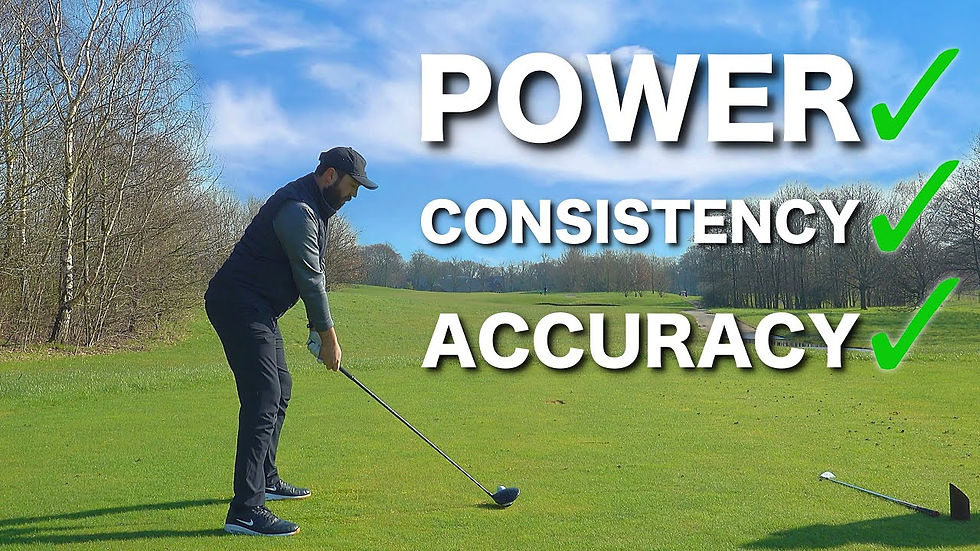PERFECT GOLF POSTURE EVERY TIME
Learn proper knee flex, hip bend, and spine alignment for consistent ball striking.
Why Watch This?
This video focuses on finding the right balance in your posture using simple drills. Key takeaways:
How knee flex and hip bend impact your balance and ball-striking consistency.
A mirror check to ensure proper spine alignment.
The importance of avoiding too much knee bend or a hunched back.
If you want a clear, structured process for perfecting your posture, this is the video for you.

PERFECT GOLF POSTURE EVERY TIME

SET UP FOR THE GOLF SWING - THE COMPLETE GOLF SWING GUIDE

How to Stand CORRECTLY to the Golf Ball!

Titleist Tips: Indoor Golf Training - Posture

BEGINNER SERIES 001: SET UP | Golf with Aimee

TIPS FOR PERFECT GOLF SWING SETUP AND POSTURE
Scroll For More Videos
Why Your Stance and Posture Matter in Golf
If grip is your connection to the club, stance and posture are your connection to the ground. A solid stance provides balance, while proper posture sets you up for a repeatable and powerful swing.
When you first try a golf stance, it feels awkward—your butt sticks out, your arms hang naturally, and you tilt forward. It might seem unnatural, but thereʼs a reason pros all have similar setups: it works.
Hereʼs why itʼs so important:
Consistency - A repeatable stance leads to repeatable shots.
Power - The right posture allows your body to coil and unleash energy efficiently.
Accuracy - Poor setup leads to compensations that make it difficult to control your shots.
As covered in our curated videos, common beginner mistakes include:
Standing too upright, leading to weak shots and inconsistent ball contact.
Bending too much from the knees instead of the hips, which restricts movement.
Holding too much weight in the heels, causing balance issues during the swing.
The good news? Itʼs easy to fix. Below, we break down the stance using both Directive-Based and Analogy-Based approaches so you can find what works best for you.
Directive-Based Approach: Step-by-Step Guide to a Proper Stance
If you learn best with clear, structured steps, follow this step-by-step guide:
1. Feet Positioning
Stand shoulder-width apart for balance.
Ball position changes based on the club:
Wedges -> Middle of the stance
Mid-Irons -> Slightly forward
Driver -> Near your lead foot
2. Weight Distribution
Keep your weight evenly distributed (50/50) between both feet.
Avoid leaning too much onto your heels or toes—your weight should feel centered in the arches of your feet.
3. Bending From the Hips (Not the Knees)
Tilt forward from your hips, not your back.
Keep your spine straight (avoid rounding your shoulders).
A proper tilt allows your arms to hang naturally down from your shoulders.
4. Knee Flex
Slight knee bend—just enough to remove stiffness but not sitting back like a squat.
Knees should point in the same direction as your toes.
5. Arm Position & Grip
Let your arms hang naturally—donʼt reach out or pull them in too close.
Hold the club lightly but firmly, keeping the grip relaxed.
Now that you have the technical breakdown, letʼs explore a more feel-based way of learning stance and posture.
Analogy-Based Approach: Feeling the Right Stance
If detailed instructions donʼt click, try these visual and physical cues to set up
correctly.
The Athletic Stance
Imagine youʼre a shortstop in baseball—feet balanced, knees flexed, weight slightly forward.
You should feel ready to react, not locked into place.
The Chair Drill
Stand near a wall and pretend to sit in a tall bar stool—this helps engage your hips without excessive knee bend
The Hanging Arms Test
Hold your club up at waist height, then hinge at your hips until the clubhead naturally reaches the ground.
If your arms feel too stretched or cramped, adjust your distance to the ball.
The Triangle Concept
Imagine a triangle formed by your shoulders and arms—this should stay intact as you swing.
Both methods lead to the same result—a balanced, athletic posture that allows you to turn efficiently and generate power.
Final Thoughts: Build a Strong Foundation for Your Swing
Mastering stance and posture is like laying the foundation for a house—without a strong base, everything built on top of it will crumble. No matter how good your swing mechanics are, if your stance is off, your swing wonʼt function the way it should.
The best part? You donʼt need a golf course, a driving range, or even a golf ball to practice this. Stance and posture are one of the few parts of golf you can work on literally anywhere.
It might feel ridiculous at first, but getting your setup right will make every part of your swing easier, more natural, and more consistent. Spend time on it now, and youʼll thank yourself later when your shots start feeling effortless and controlled.
And as always remember to GG and Have Fun.
Next Up: The Backswing—How to Load Power Efficiently
Now that your stance is dialed in, letʼs move on to creating a smooth and
powerful backswing.